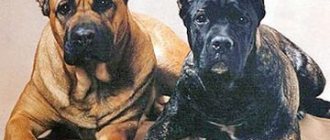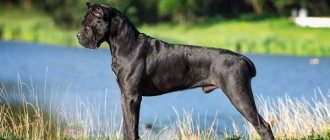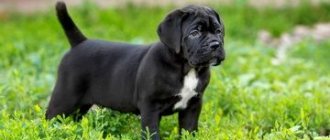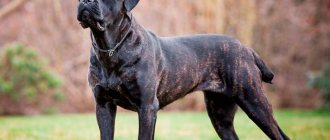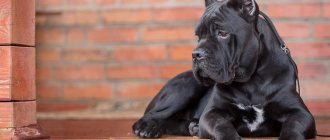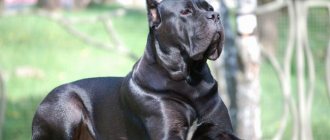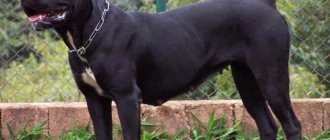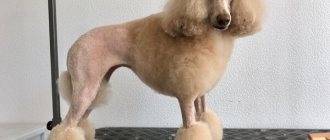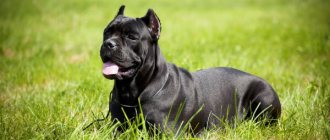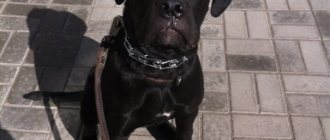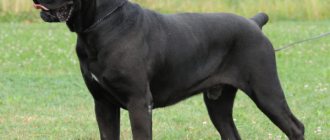Whether a Cane Corso puppy will be blue, red, brindle or black depends on its parents. Therefore, serious breeders select dogs for breeding based on science.
This is done not only for the beauty of the offspring, but also to comply with color standards, because the color of the coat indicates either the purity of the breed or a “marriage”.
We will try to talk about all the color options and how they are obtained. Knowing the basics, you can wisely choose a puppy or a mate for an adult pet - to get babies of the right color.
Color options when mating with different coat colors
Let's now take a closer look at what color options are possible when breeding dogs with different coat colors.
Absolutely black parents can produce not only black puppies, but also blue (a shade of gray), brindle, blue-brindle with a blue mask, red with a black mask and fawn with a blue mask.
Also, black parents may have a gray baby with black eyelids, lips and a gray nose. The black color is not caused by any one gene, but by the combination Ay-BD-Em-K-. You can see for yourself how much space Mother Nature has for creativity.
If you breed brindles, they will also give a variety of offspring, but there will be no black babies.
At the same time, if one of the parents has a solid color, but has at least one tiny “tiger”, he can no longer pass on the gene necessary for the formation of black color. In brindle dogs, the puppies will be brindle with a black mask, red with a black mask, blue brindle with a blue mask, or fawn with a blue mask.
If blue brindle and blue dogs are bred, then all the offspring will be light colors: the same colors as the mother and father, or light red with a blue mask, formentino.
Parents who are red with black or blue masks will produce red puppies with a black mask or fawn with a blue mask.
If you study the genetics of colors in detail, you can control the color of the coat of future babies.
Rare and non-standard colors
Over the past few years, advertisements for the sale of Italian purebred Cane Corsos have appeared on social networks or on thematic websites. Future owners are increasingly paying attention to elite dogs with Formentino, Isabella or Apricot colors. Isabella - sounds interesting, but this color is considered a reject. This is, as a rule, an ordinary gray Cane Corso, whose muzzle is not decorated with a mask.
According to the standard, four basic colors are allowed, but there are a great many variations. Owners of a chocolate or tan pet often face the fact that it is not allowed for breeding. This means that the color of the Cane Corso can only be as specified by the standard. Professional breeders all over the world will never take a male dog of non-standard color for breeding. Bitches of rare colors are allowed to participate in breeding activities, but only very rarely and not on Italian territory.
Formentino
It is a light red dog with fawn and silver coats. From the outside it seems that the above color is monotonous, but this feeling is deceptive. The animal is distinguished by a light blue or gray mask on its face, which often blends in with the main color of its coat.
Photo from Instagram account tres.nubbins
The formentino color of the Cane Corso is interesting because babies in the same litter can be born gray, black, or blue. After some time, the babies turn into adult dogs with a fawn-colored coat, but the mask does not disappear from their faces. Dogs with this color are considered discarded and will not be allowed to participate in dog shows or further breeding.
White
White cane is considered rejected, since the standards do not allow the presence of such a shade. The gene that is responsible for snow-whiteness brings mutations and destroys the ability for further selection. A baby with this coat color will be culled immediately, and they will be given documents that prohibit breeding.
Photo from Instagram account whitecanecorso
Fans of unusual animals who do not care about participating in exhibitions, on the contrary, often purchase albinos. The dogs look impressive, but the snow-white color of the coat occurs due to a dangerous gene that leads to the premature death of the cane.
Apricot
Photo from Instagram account garmr_cane_corso
The apricot-colored puppy is a red Cane Corso with a fawn coat. Breeders consider apricot to be a shade of red, so they do not consider it a separate color. They call fawn the standard color; they specify that it is more correct to call it the red color of the Cane Corso. The fur of such an animal looks like fawn, beige, or pale orange. A purebred puppy must have a dark or even black mask on its face.
Chocolate
Chocolate (liver) is similar to red, but the owner of a non-standard color will immediately be identified by the pink rim of the eye and nose. Dogs of this color have an iris that is neither black nor brown, but green, greenish-brown. A brown Cane Corso is a standard dog, while chocolate shades will lead to culling.
If a person dreams of a pet with apricot, formentino, or isabella fur, he should carefully familiarize himself with the external characteristics and behavioral characteristics. The description of the future dog show star may be banal, but she will have a unique charisma. A puppy of a fashionable non-standard color can be beautiful, but have many flaws and even genetic mutations. He will not be allowed to participate in dog shows, and will live the rest of his life as a faithful companion and favorite of all family members.
Brief history of origin
Italy is officially considered the birthplace of this dog. The distant ancestors of the Cane Corso - Molossian dogs - lived in Ancient Rome. They had many functions: guard (protection of the owner’s property and himself) and military service, participation in gladiatorial battles and hunting, even monitoring children. Therefore, their main qualities were large size, fearlessness, and devotion to man.
Over the thousand years of its existence, the breed has undergone some changes, and yet the appearance of the dog has changed slightly. The number of Cane Corsos decreased by almost half during the First World War. The breed was on the verge of extinction during World War II - these dogs were poorly fed due to lack of food.
Despite all the difficulties, today the Cane Corso is one of the most beautiful and popular breeds not only in Italy, but throughout the world. Much credit goes to Giovanni Nizzo for this. This Italian, together with like-minded people, gathered representatives of the breed from all over the country in the early 80s of the last century and created a nursery.
For the first time, Cane Corso breeding began there on a professional level.
Already in the 90s, the FCI established standards that today are met by more than 3,000 representatives of the Italian Mastiff (the second name of the breed) around the world. Changes were made to them in 2016. In the new version, the approach to docking the Cane Corso's ears and tail has changed.
Comparison with other breeds
The impressive dog can easily compete with other guard and service breeds and play the role of a family pet and companion. Compared to other dog breeds, Cane Corso dogs have the following characteristics :
- The level of attachment to family members and the owner of the Cane Corso is higher than that of a German Shepherd or Labrador, the same as that of a Doberman Pinscher or Great Dane, and lower than that of a Boston Terrier or Shih Tzu.
- ' training abilities are higher than those of a bulldog or Newfoundland, on par with a Cane Corso or Doberman, and lower than those of a Labrador or Border Collie.
- The activity level is higher than a St. Bernard or Central Asian Shepherd, on par with a German Shepherd, and lower than a Doberman or Labrador.
- Aggression towards animals is higher than that of a Labrador or Great Dane, on a par with the Central Asian Shepherd or Boxer, and lower than that of a German Shepherd or Doberman.
- Security qualities are higher than those of other companion breeds, on the same level as Great Dane or Mastino and lower than those of Doberman Pinscher or German Shepherd.
- Cane Corso are physically strong dogs, their level of muscular strength is higher than that of Akita Inu or Doberman, Cane Corso and Rottweiler are on the same level, and Mastino or St. Bernard are much stronger.
Cane Corso price
The price for an Italian Cane Corso in kennels starts from $1000. The most expensive puppies are of rare color and promising (from parents who have received recognition at international exhibitions). You can buy a dog for a lower price, but in this case it will most likely be without documents and with any defects.
Although for people who do not intend to exhibit their pet, but simply want to have a loyal friend and a good guard, the wrong color or whitish eyes are unlikely to become a serious problem.
Dog character
The Cane Corso is a guard, ready at any moment to protect the family in which he lives from enemy attack.
Moreover, he perfectly differentiates not only people, but also animals into friends and strangers.
Cane Corso have a strong attachment to their owner, and in his absence they become very sad and may even experience a feeling of panic . Loneliness is extremely difficult to tolerate.
The Cane Corso can attack an enemy even without the owner's command, but only if the owner is in real danger.
As for their attitude towards other dogs, Cane Corsos are not the first to attack, but they tend to succumb to provocation.
NOTE!
They may well coexist with other animals, including cats, especially if the animal was adopted by a family when it was a kitten.
This is an excellent protector and friend for children; they are very careful with family members who are significantly weaker than them..
Cane Corso are lively and active dogs that are suitable for people who live in their own home and have a persistent character.
Read more about the character traits of the Cane Corso here.
How to choose?
Before choosing a Cane Corso puppy, you need to choose a kennel. It is important that the nursery maintains the purity of the breed and its quality.
It is necessary to pay attention to:
- cost of a puppy – quality Blue Corso puppies cost from $250 to $1,500;
- nursery conditions;
- availability of documents for puppies;
- presence of pedigree;
- the behavior of the breeder himself.
The puppy must be strong, well-fed, active and courageous . It is best to ask the breeder to show the puppy's father and mother, then the breed standard can be assessed.
IMPORTANT!
The puppy must have a puppy certificate and an international veterinary passport, which contains information about vaccinations and helminth prevention.
Such a document is issued 45 days after the birth of the puppies.
There must be a mark on the dog’s belly that corresponds to what is indicated in the metric.
